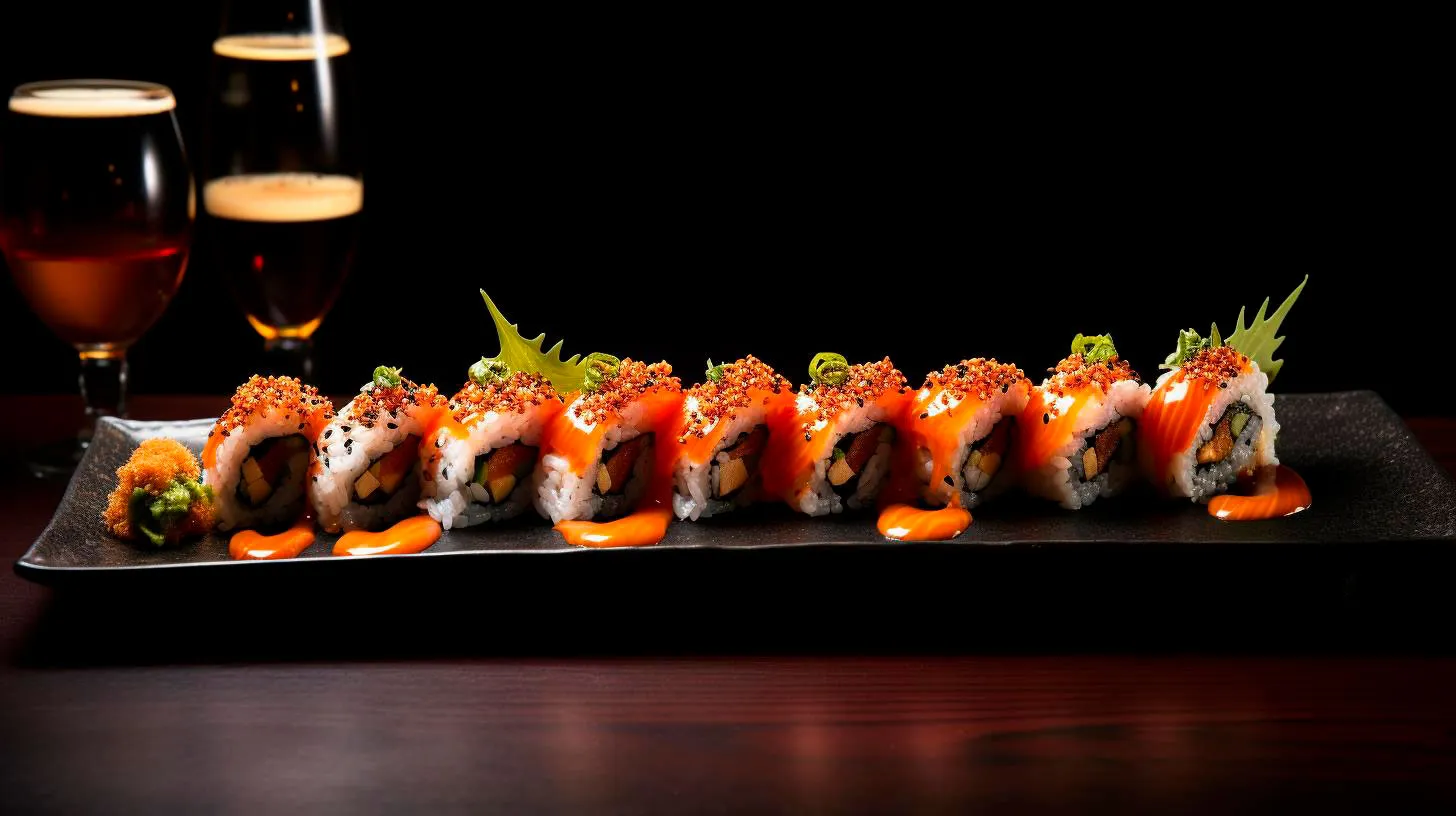Step-by-Step Guide to Preventing Sushi Rice Mold at Home
In this step-by-step guide, we will explore effective techniques to prevent sushi rice mold at home, ensuring that your homemade sushi remains fresh and safe to consume.
The Importance of Preventing Sushi Rice Mold
Sushi rice mold, also known as “kabi,” is a type of fungus that can grow on cooked rice, especially when it is improperly stored. Mold growth not only ruins the taste and appearance of sushi rice but can also pose health risks. Consumption of mold-contaminated rice can lead to foodborne illnesses, including digestive problems and allergic reactions.
To prevent the growth of sushi rice mold, it is essential to follow specific steps and guidelines. Let’s dive into the step-by-step process to keep your sushi rice mold-free and delicious:
Step 1: Cooking the Rice
Properly cooked rice is the foundation of any good sushi. Ensure that you follow these tips:
- Use short-grain sushi rice for the best results.
- Rinse the rice thoroughly to remove excess starch.
- Follow the recommended water-to-rice ratio.
- Cook the rice in a rice cooker or on the stovetop, following the instructions on the package.
By cooking the rice correctly, you create a suitable environment to prevent mold growth.
Step 2: Seasoning the Rice
Next, it’s time to season the cooked rice to give it the signature sushi flavor. Here’s what you should do:
- Transfer the cooked rice to a wooden or non-metallic bowl.
- Sprinkle sushi vinegar, a mixture of rice vinegar, sugar, and salt, over the hot rice.
- Gently fold and mix the rice with a wooden spatula or rice paddle to evenly distribute the seasoning.
Seasoning the rice not only adds flavor but also helps in preventing mold formation.
Step 3: Cooling and Storing the Rice
After seasoning, it is crucial to cool and store the rice properly to prevent mold growth. Follow these steps:
- Spread the seasoned rice evenly on a large, flat surface like a wooden sushi oke or baking sheet.
- Allow the rice to cool naturally at room temperature for about 30 minutes, avoiding direct sunlight or humid environments.
- Once cooled, cover the rice with a damp cloth or plastic wrap to retain moisture.
- Store the rice in an airtight container and place it in the refrigerator, keeping it separate from other food items to prevent cross-contamination.
Proper cooling and storage inhibit the growth of mold on the sushi rice, maintaining its freshness and quality for a longer time.
Step 4: Handwashing and Sanitization
Before handling the rice and preparing sushi, it is crucial to ensure proper handwashing and sanitization. Here are some key points to remember:
- Wash your hands thoroughly with soap and warm water before touching the rice or any sushi ingredients.
- Sanitize the utensils, cutting boards, and any surfaces that come into contact with the rice to prevent cross-contamination.
- Use clean and dry utensils, preferably wooden or non-metallic, when handling the rice.
Practicing good hygiene significantly reduces the risk of mold contamination and maintains the quality of your sushi rice.
Key Takeaways
Preventing sushi rice mold at home requires attention to detail and adherence to specific guidelines. Here are the key takeaways:
- Properly cook the sushi rice and use short-grain rice for the best results.
- Thoroughly rinse the rice before cooking to remove excess starch.
- Season the rice with sushi vinegar to enhance flavor and inhibit mold growth.
- Cool the rice at room temperature, avoiding direct sunlight.
- Store the rice in an airtight container in the refrigerator, keeping it separate from other foods.
- Practice good handwashing and sanitization before handling the rice.
By following these steps, you can enjoy delicious homemade sushi without the worry of mold contamination. Remember, sushi rice mold prevention not only ensures a great culinary experience but also keeps you and your loved ones safe from potential health risks. Bon appétit!
Identifying Mold Growth on Sushi Rice: Signs and Symptoms
In this article, we will explore the signs and symptoms of mold growth on sushi rice, as well as ways to prevent it from developing. Let’s dive in!
The Importance of Identifying Mold on Sushi Rice
Mold is a type of fungus that thrives in warm, humid environments. Unfortunately, sushi rice provides the perfect conditions for mold to grow, as it is moist and often stored at room temperature. Consuming sushi with moldy rice can lead to various health issues, including food poisoning. Therefore, it is crucial to be able to identify the signs and symptoms of mold growth on sushi rice to ensure your dining experience remains safe and enjoyable.
Key Signs of Mold Growth on Sushi Rice
Here are some telltale signs that indicate the presence of mold on sushi rice:
- Fuzzy Texture: Mold on sushi rice can appear as a layer of fuzzy, discolored growth on the rice grains.
- Unpleasant Odor: Moldy rice often emits a musty or sour smell that is different from the normal aroma of fresh sushi rice.
- Discoloration: Mold can cause the rice to have uncharacteristic hues or dark spots, indicating the presence of mold spores.
It is important to note that some molds can produce mycotoxins, which are toxic substances that can cause allergic reactions and adverse health effects. Therefore, it’s best to err on the side of caution and avoid consuming sushi rice that shows any signs of mold growth.
Preventing Mold Growth on Sushi Rice
Now that we know the signs and symptoms of mold growth on sushi rice, let’s explore preventive measures to ensure your sushi rice remains mold-free:
- Storage: Properly store sushi rice by keeping it in an airtight container in the refrigerator. This helps maintain a cool and dry atmosphere, reducing the chances of mold growth.
- Expiration Dates: Always check the expiration dates when purchasing sushi rice. Using expired rice increases the likelihood of mold growth.
- Quality Ingredients: Use fresh, high-quality sushi rice from reputable suppliers. Quality ingredients are less likely to harbor mold spores.
- Hygiene: Ensure good hygiene practices when preparing sushi rice. Wash your hands thoroughly before handling the rice and use clean utensils to prevent cross-contamination.
- Regular Inspections: Regularly inspect the sushi rice for any signs of mold growth before using it in your sushi creations. Remember, it’s better to be safe than sorry!
Conclusion
Mold growth on sushi rice can pose a risk to your health and compromise your dining experience. By being aware of the signs and symptoms of mold growth, you can effectively identify and avoid consuming contaminated sushi rice. Remember to store your sushi rice correctly, prioritize quality ingredients, and maintain proper hygiene during preparation. Stay vigilant, and enjoy your fresh and delicious sushi worry-free!
Key Takeaways:
- Identifying mold growth on sushi rice is crucial for maintaining the safety and quality of the dish.
- Signs of mold on sushi rice include fuzzy texture, unpleasant odor, and discoloration.
- Mycotoxins produced by some molds can have adverse health effects.
- Preventive measures include proper storage, checking expiration dates, using quality ingredients, maintaining hygiene, and regular inspections.
Remember, it’s always better to be safe than sorry when it comes to enjoying your favorite sushi!
The Effects of Rice Mold on Sushi Quality
However, rice mold can have a detrimental impact on the quality and taste of sushi. In this article, we will explore the effects of rice mold on sushi quality and discuss ways to prevent and overcome this issue.
Understanding Rice Mold
Rice mold, scientifically known as Aspergillus oryzae, is a type of fungus that commonly affects rice grains. This mold is responsible for producing enzymes that break down complex carbohydrates in rice, resulting in the fermentation process. While this fungus is traditionally used in sake and miso production, it can become a problem when it affects sushi rice.
The Impacts on Sushi Quality
Rice mold can significantly diminish the quality of sushi. Here are some effects it has on the final product:
- Off-flavors: Mold-infected rice can develop unpleasant flavors, making the sushi taste sour, bitter, or musty.
- Texture changes: The presence of mold can alter the texture of the rice, making it stickier or mushier than desired.
- Presentation: Sushi is known for its aesthetically pleasing appearance, and rice mold can cause discoloration, making the sushi visually unappealing.
- Food safety concerns: While rare, some molds can produce harmful toxins that can cause food poisoning. Therefore, it is crucial to prevent mold growth to ensure sushi is safe to consume.
Preventing Rice Mold
The best way to deal with rice mold is to prevent its occurrence altogether. Here are some effective preventive measures:
- Clean utensils and equipment: Thoroughly wash and sanitize all utensils, pots, and pans used in the sushi rice preparation process to eliminate any existing mold spores.
- Air ventilation: Allow sufficient air circulation in the rice storage area to prevent the moisture buildup that encourages mold growth.
- Refrigeration: Store sushi rice in cool temperatures (around 4°C or 39°F) to slow down mold proliferation.
- Regular inspection: Frequently examine rice for any signs of mold growth and discard affected grains immediately.
Overcoming Rice Mold
If, despite preventive measures, rice mold still affects your sushi rice, consider the following actions:
- Rice washing: Thoroughly rinse the rice before cooking to remove any potential mold spores.
- Replacement: If you discover mold during or after cooking, discard the entire batch of rice and start fresh.
- Monitoring: Implement a monitoring system to ensure the quality and safety of the rice used in sushi preparation.
- Collaboration: Work closely with suppliers to ensure rice quality, ensuring it is stored and transported under appropriate conditions.
Key Takeaways
Rice mold can significantly impact the quality, taste, and overall experience of sushi. Understanding how to prevent and overcome rice mold is crucial for sushi chefs and enthusiasts alike. Here are the key takeaways to remember:
- Mold-infected sushi rice can lead to off-flavors, texture changes, and compromised food safety.
- Cleanliness, proper storage, and regular inspections are key preventive measures.
- Rice affected by mold should be discarded immediately, and steps should be taken to prevent further contamination.
By being mindful of the presence of rice mold and following the necessary precautions, you can ensure that the sushi you create or enjoy is of the highest quality, both in taste and presentation.
Common Causes of Sushi Rice Mold and How to Avoid Them
Let’s dive in!
Understanding the Causes of Sushi Rice Mold
Sushi rice mold occurs when the ideal conditions for mold growth are present. These conditions include:
- Moisture: Excess moisture is one of the primary reasons for sushi rice mold. When rice is not properly cooked or cooled, moisture levels can become too high, providing an optimal environment for mold growth.
- Temperature: Mold thrives in warm temperatures, between 68 to 86 degrees Fahrenheit. If you store your sushi rice at a temperature within this range, mold can grow rapidly.
- Air Circulation: Poor air circulation around your sushi rice can contribute to mold growth. Inadequate ventilation can trap moisture, creating a breeding ground for mold spores.
- Contamination: Mold spores can be introduced to sushi rice through contaminated utensils, ingredients, or even improper hygiene practices in the kitchen.
How to Prevent Sushi Rice Mold
1. Cook and Cool Rice Properly
Properly cooking and cooling sushi rice is vital to prevent mold growth. Follow these steps:
- Wash rice thoroughly to remove excess starch.
- Cook rice with the appropriate water-to-rice ratio.
- After cooking, let the rice sit covered for 10-15 minutes to allow it to firm up.
- Transfer rice to a flat surface and fan it gently to cool it down quickly.
2. Store Rice at Lower Temperatures
When you are not using or serving sushi rice, it is crucial to refrigerate it promptly. Ideally, keep the sushi rice between 32 to 41 degrees Fahrenheit to inhibit mold growth. This temperature range helps slow down bacterial growth as well.
3. Ensure Proper Air Circulation
Proper air circulation is key to prevent moisture buildup. When storing sushi rice, ensure that it is not tightly enclosed. Avoid using airtight containers, as they can trap moisture and make it easier for mold to develop. Instead, opt for loosely covered containers or wrap the rice in a clean, breathable cloth.
4. Maintain a Clean Environment
Prevent contamination by maintaining a clean and hygienic kitchen environment. Here are some tips:
- Regularly clean all utensils used for handling sushi rice.
- Sanitize food preparation surfaces before and after use.
- Store ingredients separately to avoid cross-contamination.
- Adhere to proper personal hygiene practices, including washing hands frequently.
Key Takeaways
Moldy sushi rice can be a disappointing experience, but by understanding the causes and implementing preventive measures, you can safeguard against it. Here’s a quick summary:
- Mold on sushi rice is caused by excess moisture, warm temperatures, poor air circulation, and contamination.
- Cook rice properly and cool it down efficiently to minimize moisture levels.
- Refrigerate sushi rice between 32 to 41 degrees Fahrenheit to inhibit mold growth.
- Ensure proper air circulation around the rice by using loosely covered containers or breathable cloth wraps.
- Keep your kitchen clean and practice good hygiene to avoid contamination.
By following these simple yet effective steps, you can enjoy your favorite sushi without the unwelcome presence of mold. Take charge of your sushi rice preparation and savor the delight of a mold-free dining experience!


